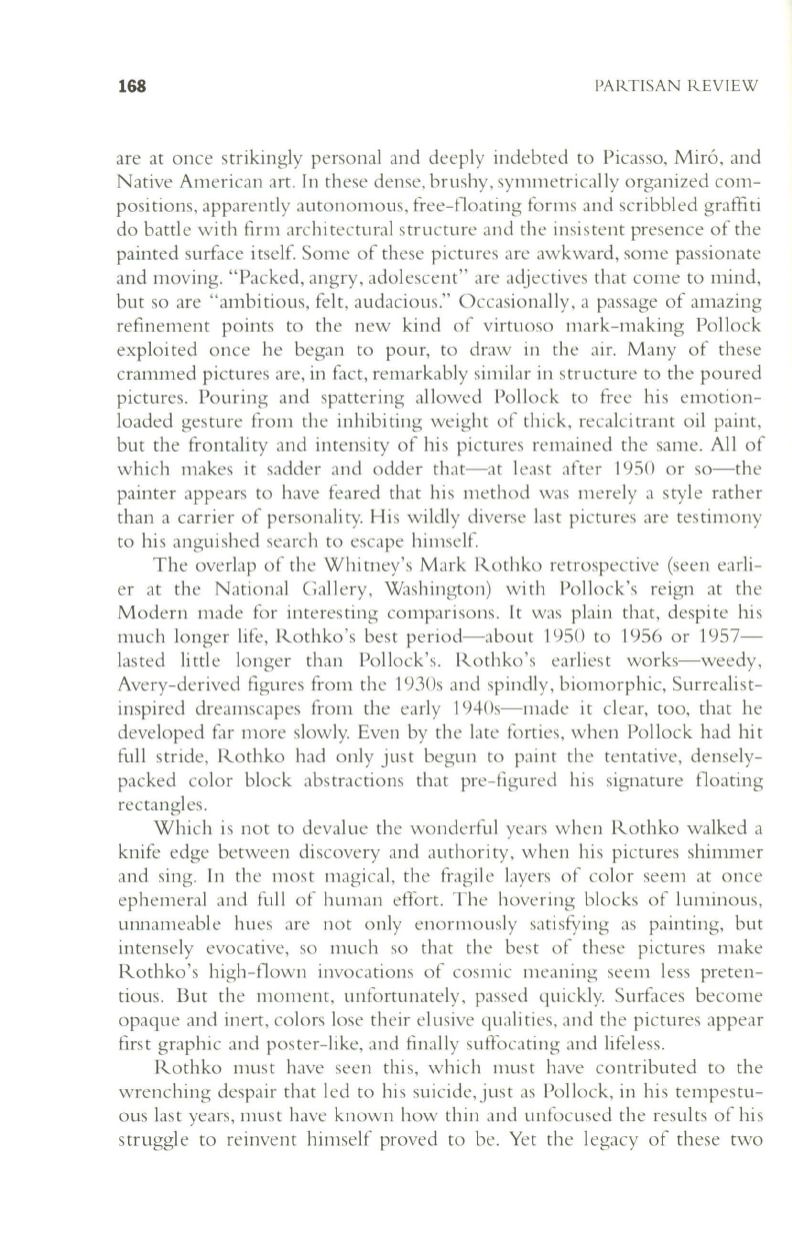
168
PARTISAN REVIEW
are at once strikingly personal and deeply indebted to Picasso, Mira, and
Native American art. In these dense, brushy , symmetrically organized com–
positions, apparently autonomous, free-floating forms and scribbled graffiti
do battle with firm architectural structure and the insistent presence of the
painted surface itself. Some of these pictures are awkward, some passionate
and moving. "Packed, angry, adolescent" are adjectives that come to mind,
but so are "ambitious, felt, audacious." Occasionally, a passage of amazing
refinement points to the new kind of virtuoso mark-making Pollock
exploited once he began to pour, to draw in the air. Many of these
crammed pictures are, in fact, remarkably similar in structure to the poured
pictures. Pouring and spattering allowed Pollock to free his emotion–
loaded gesture from the inhibiting weight of thick, recalcitrant oil paint,
but the frontality and intensity of his pictures remained the same. All of
which makes it sadder and odder that-at least after 1950 or so-the
painter appears to have feared that his method was merely a style rather
than a carrier of personality. His wildly diverse last pictures are testimony
to his anguished search to escape himself.
The overlap of the Whitney's Mark Rothko retrospective (seen earli–
er at the National Gallery, Washington) wi th Pollock's reign at the
Modern made for interesting comparisons.
It
was plain that, despite his
much longer life, Rothko's best period-about 1950 to 1956 or 1957-
lasted little longer than Pollock's. Rothko's earliest works-weedy,
Avery-derived figures from the 1930s and spindly, biomorphic, Surrealist–
inspired dreamscapes from the early 1940s-made it clear, too, that he
developed far more slowly. Even by the late forties, when Pollock had hit
full stride, Rothko had only just begun to paint the tentative, densely–
packed color block abstractions that pre-figured his signature floating
rectangles.
Which is not to devalue the wonderful years when
I~othko
walked a
knife edge between discovery and authori ty, when his pictures shirnmer
and sing. In the most magical, the fi'agile layers of color seem at once
ephemeral and full of human effort. The hovering blocks of luminous,
unnameable hues are not only enormously satisfYing as painting, but
intensely evocative, so much so that the bes t of these pictures make
Rothko's high-flown invocations of cosmic meaning seem less preten–
tious. But the moment, unfortunately, passed quickly. Surfaces become
opaque and inert, colors lose their elusive quali ties, and the pictures appear
first graphic and poster-like, and finally suffocating and lifeless.
Rothko must have seen this , which must have contributed to the
wrenching despair that led to his suicide, just as Pollock, in his tempestu–
ous last years, must have known how thin and unfocused the results of his
struggle to reinvent himself proved to be. Yet the legacy of these two


